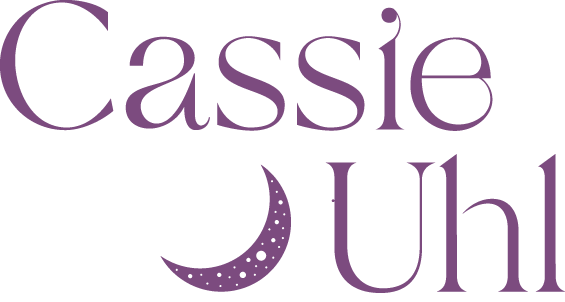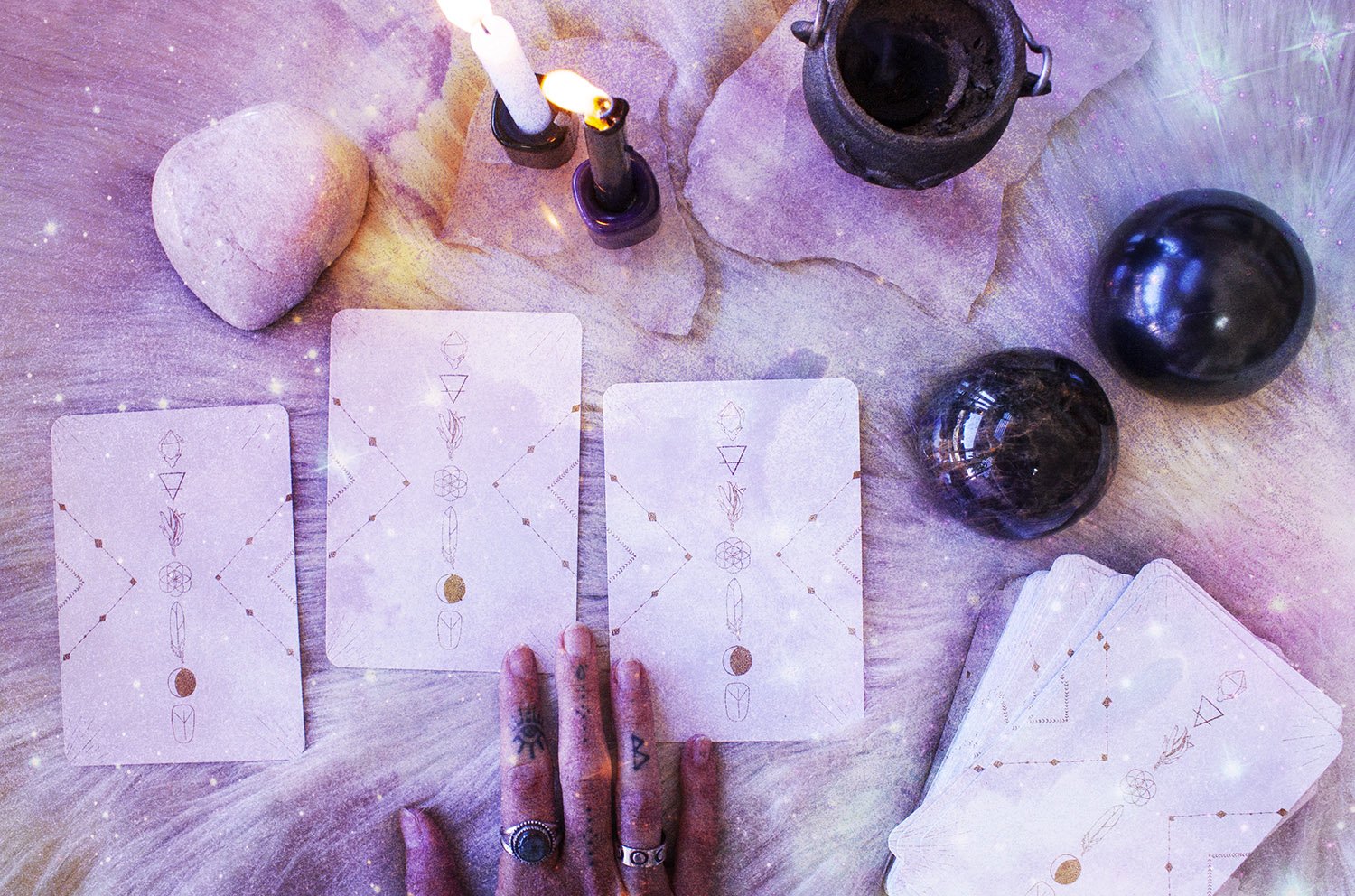A Card Spread for the Winter Solstice
The winter solstice, or Yule, is the year's shortest day and longest night. Yule is a sabbat on the Wheel of the Year that marks midwinter, and even though it’s the darkest time of the whole year, it represents a time of death and rebirth. Here is a card spread to help identify, grieve, and release what’s ready to be shed and reborn within yourself this season.
6 Ways to Work With Your Tarot Cards Besides Divination
Divination is a fantastic way to work with the tarot, but you’re selling yourself short with your trusted tarot deck if you’re only using it to glean insights into the future. At its core, and in my opinion, the tarot is a powerful self-reflective tool. It’s here to share insights and guidance about what’s going on with you right now, at this moment. Telling the future is one of the most common draws to tarot, but the tarot truly brings a host of other benefits.Read on for six ways to work with the tarot to grow and expand in new ways, aside from divination.
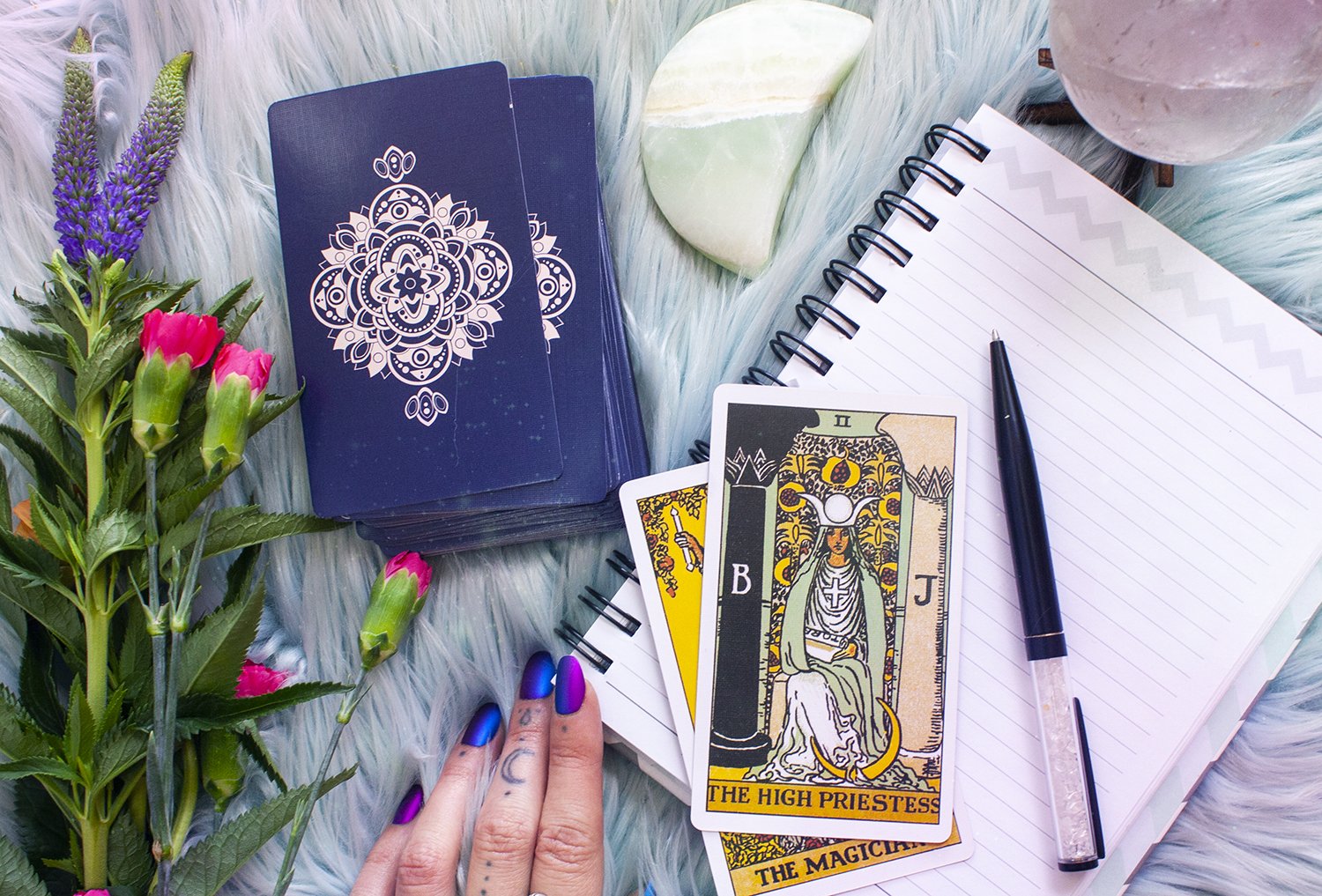
Divination is a fantastic way to work with the tarot, but you’re selling yourself short with your trusted tarot deck if you’re only using it to glean insights into the future. At its core, and in my opinion, the tarot is a powerful self-reflective tool. It’s here to share insights and guidance about what’s going on with you right now, at this moment. Telling the future is one of the most common draws to tarot, but the tarot truly brings a host of other benefits.
Read on for six ways to work with the tarot to grow and expand in new ways, aside from divination.
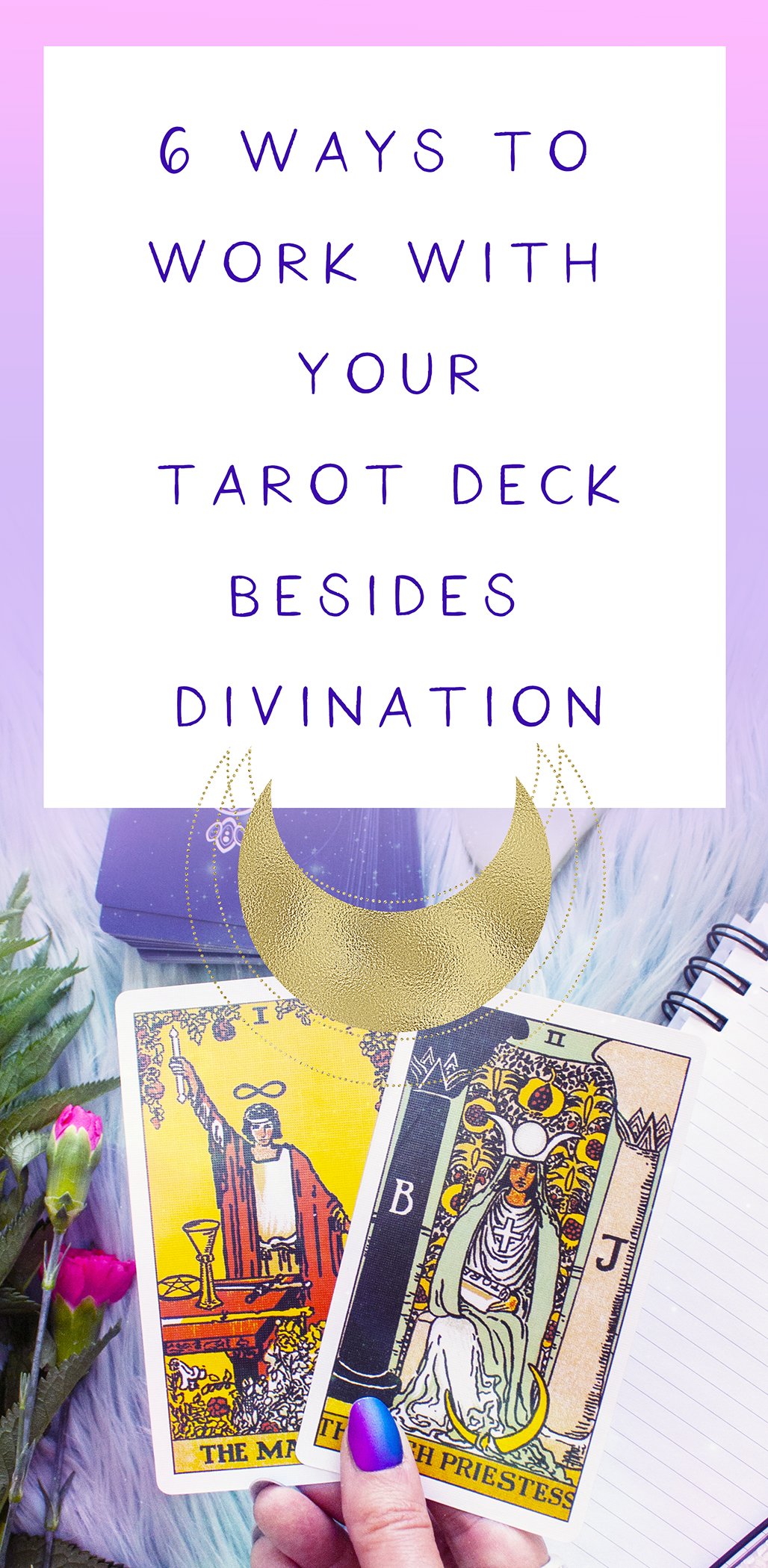
Working with Common Archetypes
The tarot is full of common archetypes that you will encounter or embody at different times in your life. Archetypes are timeless and universal energies that people can understand across cultures. For example, the archetype of the mother is something we can all understand on some level. Even if you do not have a relationship with your biological mother or have children of your own, the overarching energy of the archetype of the mother is something you can understand. Furthermore, you do not have to be a mother or a woman to embody the mother's archetype. Anyone can access and learn from the energy of motherhood.
The tarot is dripping with common archetypes, especially in the major arcana. The way the archetypes show up can be personal and vary from person to person. Most of the common archetypes appear in the major arcana, but they can also be found in the minor. Here are some of the archetypes I associate with the cards: the ego (the sun), soul (the moon), mother (empress), father (emperor), wizard (magician), child (the fool), lover (the lovers), martyr (hanged one), seer (hermit), and authoritarian (hierophant), etc. You may decide on different archetypal associations with different cards, and that’s fine.
So, how can you work with the archetypes of the tarot? Lots of ways! You can explore how the archetypal energies associated with the cards make you feel, you can look at the symbology on each card and explore how it makes you feel about its archetype, you can journal about the cards and their archetypal connections, and you can layer it into how you interact with and understand the cards.
Journaling
Journaling allows you to dive deep into the meaning and energy of each card. You’ll better understand the lessons each card wants to offer you through journaling about them. Truth be told, I’m not a big fan of journaling. Journaling with the tarot is different, though. I always write when I pull cards for myself. To begin journaling with the cards, you can work through them one at a time in order or intuitively select a card to journal about. Here are some suggestions for questions to ask yourself when you’re journaling about different cards:
How does this card make me feel?
What symbols or imagery jumps out to me?
Are there any archetypes or human themes that stand out to me in this card?
How does this card show up in my life right now?
What can I learn from this card?

Energy Readings
If you’ve followed my work long, you already know that I love all things energy! We are energy beings, and the tarot is another magical and beautiful way to work with your energy. What do I mean by this? Tarot is an excellent tool for reading your energy and understanding how to balance your energy.
Each card in the tarot corresponds with different energy. When you work with the cards specifically to assess your energy, the cards can act as a guide for what kind of energy you may need more or less of. Each card's energy can act as a signal that you either have too much or too little of that energy.
For example, if you pull some cards to determine what your energy needs to be more balanced and you pull loads of pentacles, that would be a sign that you need more grounding in your life to feel more balanced because the pentacles relate to the element of earth.
You could also consider pulling a card for each energy center or chakra in your body to get an idea of what each energy center needs to be in better balance. I dive into this more in-depth in my book, The Zenned Out Guide to Understanding Tarot.
Exploring and Understanding Common Correspondences
If you’re a visual learner, like I am, you’ll love working with the tarot to understand common correspondences better. I won’t spend too much time talking about this here because I already covered this in a previous post here.
Basically, each of the cards has a handful of correspondences (correspondences are simply energies that match or “play well together.”) The most common correspondences are the elements, astrological energies, and numerology. I’ve found that using the tarot as a tool to understand different types of energies better is immensely helpful, especially for visual learners. The cards' symbology and meanings will add a depth of understanding to your astrology, numerology, or elemental practice. You’ll also learn the tarot card meanings faster as well.
Shadow work
The cards of the tarot contain a complete range of human experiences. It does not gloss over the hard, scary, and sometimes earth-shattering parts of life. This is one reason why, I believe, so many are nervous about diving into tarot. It’s also why it can be such a powerful healing tool.
Your cards will not shield you from your shadow. Instead, they call you to cozy up to your shadow to understand better what it has to teach you. If the idea of shadow work is new to you, check out this previous post to learn more about what shadow work is. Here are a few ways to dive into shadow work using your tarot card deck.
Journal about the cards that make you the most uncomfortable. Use the questions above from the journaling section.
Ask questions specifically to explore your shadow, like “What parts of my shadow need healing and exploring?”, “ What do I have to learn from my shadow?” or “What parts of my shadow have I been avoiding?”
Spellwork & Magick
If you’re a fan of spellwork, altars, or magick, this one’s for you (it’s also another one of my favorite ways to work with my deck.) Because each tarot card carries a unique energy, they are perfect for adding energy and intention to spellwork, magick, and your altar. Here are a couple of ways to start working your cards into your magickal practice.
Place a card on your altar to invite in a specific kind of energy. For example, if you’re focusing on improving your intuition, you could place the moon, the high priestess, or the queen of cups on your altar as a reminder and energetic intention.
Add a card to your spell. For example, if you’re focusing on bringing more abundance into your life, you could include the nine of pentacles or the empress into your spell.

Want to learn more about working with the tarot? Order my book, The Zenned Out Guide to Understanding Tarot. Or, check out some of these posts: Understanding Tarot Correspondences, The Difference Between Tarot and Oracle, 7 Tarot Myths Debunked or Understanding Tarot Birth Cards.
Dreamwork 101 // What is Dreamwork and How to Get Started in 5 Steps
Dreamwork is the practice of tending to our relationship with our dreams. We’re dreaming every night, but many of us barely remember our dreams, or if we do, don’t spend much time thinking about them or working with them.(How often have you dismissed a dream as, “oh, it was just a dream?”)

Dreamwork is the practice of tending to our relationship with our dreams. We’re dreaming every night, but many of us barely remember our dreams, or if we do, don’t spend much time thinking about them or working with them.
(How often have you dismissed a dream as, “oh, it was just a dream?”)
But dreams can have a lot to teach us and offer us when we enter into a deeper relationship with them. The dreamworld is rich with feelings, desires, needs, and possibilities. Our understanding of what the dreamworld evokes and presents can support our physical lives and our connections to ourselves.
In this blog post, I’ll share a bit about how to start a dreamwork practice of your own.
Dreamwork Lineage
First, I’d like to share my dreamwork lineage. What I know about dreamwork comes from the work of these folks in particular, as well as my own intuition and my ancestors:
These are wonderful people to go deeper into dreamwork with if you feel so called.
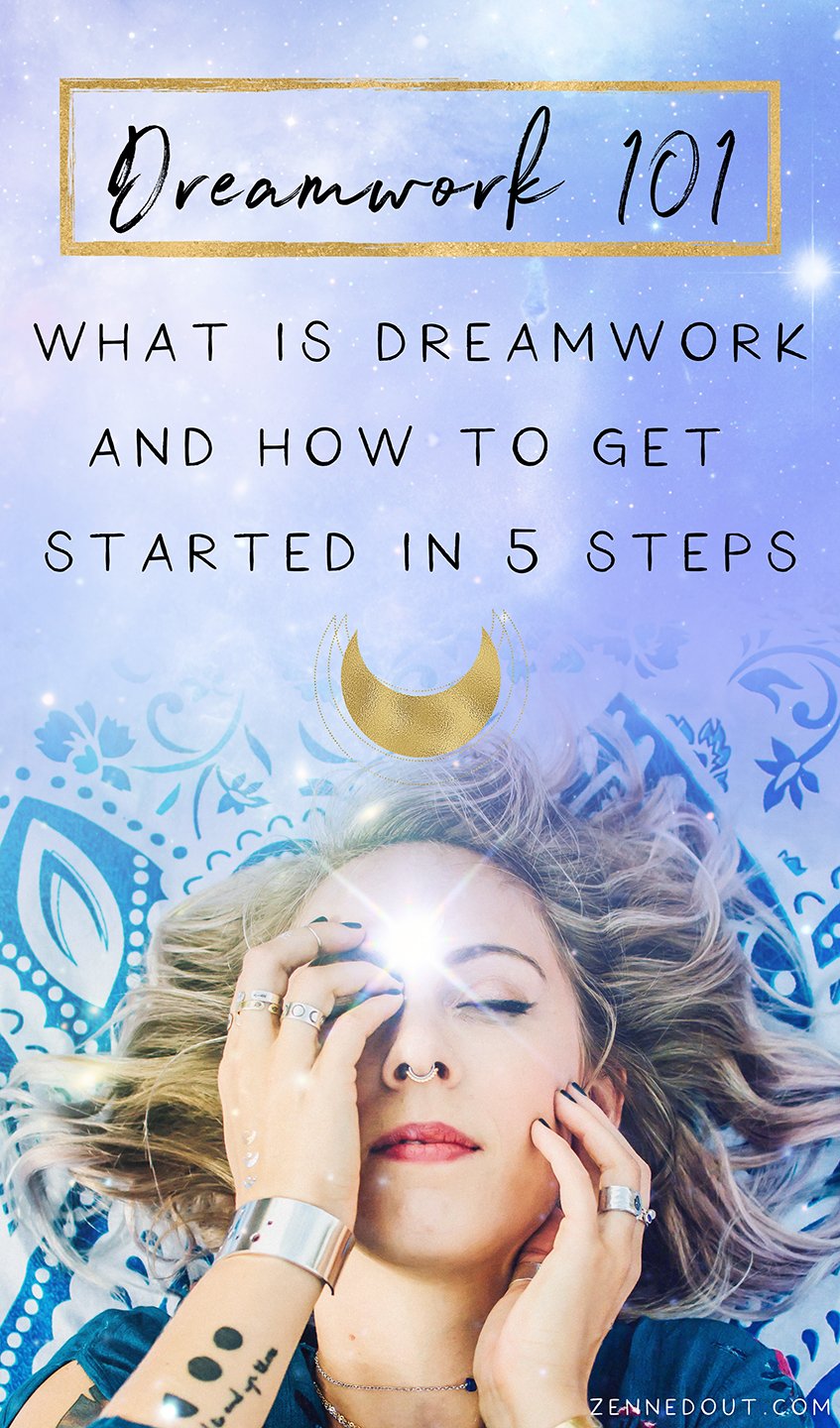
1. Support Dream Recall + Sleep
The simplest of ways to begin supporting your dreaming is by supporting sleep and dream recall. It’s difficult to consciously work with our dreams if we’re not sleeping well or can’t remember our dreams when we wake up. Everyone is different, but here are some things you might like to explore to support your sleep:
Set screen time boundaries for a certain amount of time before bed
Drink a tea to support your sleep, like chamomile (always do your own research and check with a professional before ingesting herbs)
Create your own sleep ritual that helps you shift into rest mode
Meditate and/or do a gentle, restorative yoga practice
Take a few minutes to journal brain-dump style to help clear your mind.
To support your dream recall, there are a few things I find helpful:
Set an intention to dream and to remember your dream(s) before you go to sleep (you can write this down, say it out loud, or just tell it to yourself silently)
Take a few minutes in bed in the morning before you get out of bed (or look at your phone) to give yourself space to remember your dream.
Create a dream altar and meditate at it before bed to welcome your dreams to come
Pay attention to the dreams you do receive by tending them (more on that below!)

2. Start a Dream Journal
This is probably the number one tip anyone you ask about dreamwork will give you, and with good reason! A dream journal creates a container for tending your dreams, helps solidify your intention to connect with your dreams, and helps you understand your dreams.
I recommend choosing a dedicated journal for your dreamwork and placing it on your dream altar when you’re not using it if you have one. As soon as you wake up (definitely before you look at any devices), put pen to paper and record your dream. Try recording your dreams in the present tense to honor its aliveness (for example, instead of "I was walking by a river,” try “I’m walking by a river).
If it feels available to you, you might like to marinate in the dream in bed for a few minutes before actually getting up and reaching for your journal to record.
3. Explore Dream Feelings & Textures
After you record your dream, there are many ways to work with it more deeply and explore the messages it might have for you.
I like to explore the dream textures: what are the textures, sights, smells, tastes, sounds of the dream? What do those senses mean for you and evoke for you? How do they make you feel? How does the dream, in general, make you feel?
4. Understand Dream Associations
As you work with the dream you’ve recorded, notice what stands out to you. Maybe your red dress feels particularly alive, or the hawk sparks something for you, or you feel curious about a figure in your dream.
Whatever you feel curious about, do a bit of freewriting about it. List out: what does this thing make you think of? How does it make you feel?
For example, some associations that come up with hawks for me:
Hawk feather
Maggie Smith’s poetry book Good Bones
Mothers
Protecting your children
Imagination
Play
Notice how I’m not so focused on the hawk itself, but I follow the threads of what each thing is associated with! Now I have something interesting to work with and can ask myself questions like, "what’s my relationship with play right now?"
Some of the associations you make might really surprise you and can offer deeper insight into your dream.
5. Assign Dream Correspondences
As you continue to work with your dreams, you start to develop some personal symbols and correspondences.
Like you saw above in my example with the hawk, I could make a section in my journal where I note that hawk led me to mothers and children and play. When I see a hawk again in my dream, I have that reference and can ask myself if/how it applies to this dream.
Over time, you can deepen your understanding of your own personal dream symbols and correspondences. I love this practice so much because, to me, it’s not about what a certain symbol means but about what it means to you, how it feels in your body, how it resonates with your ancestry. That’s what feels potent and powerful!
Dreams Aren’t Your Personal Vending Machine
It feels important to state that working with dreams isn’t just asking a question and receiving an answer. Generally, it’s not a simple or linear way of working. There isn’t one true or hidden meaning that we need to uncover.
In my eyes, dreams and the dreamworld are alive. So it truly is a practice of engaging in relationship with, of exploring. You might like to ask yourself, "how can I be in equal exchange with my dreams?" How can I honor the dream world and not just extract from it?
Dreams have such potential to expand us out of binary thinking and into visionary possibilities, especially if we acknowledge that power and allow them to take us there!
Going Deeper with Your Dreams
Another way to explore dream tending and go a bit deeper is by asking for a dream. I share how to do this in the dreamwork ritual I shared for Pisces season, which you can find here.
Feel free to contact us and share: how is your dream practice going? How is your relationship with your dreams evolving?
Sinking into acceptance // 4 Rituals for the Waning Moon + Card Spread
The waning moon phase is nature's way of calling you inward. How can you truly know what you need to release, shed, or let go of if you haven't allowed yourself time to go inward and fully experience your emotions? This phase is your invitation to feel and allow.The waning moon phases occur after the peak of the full moon to the dark moon. Energetically this phase represents a time of allowance, acceptance, and shedding.
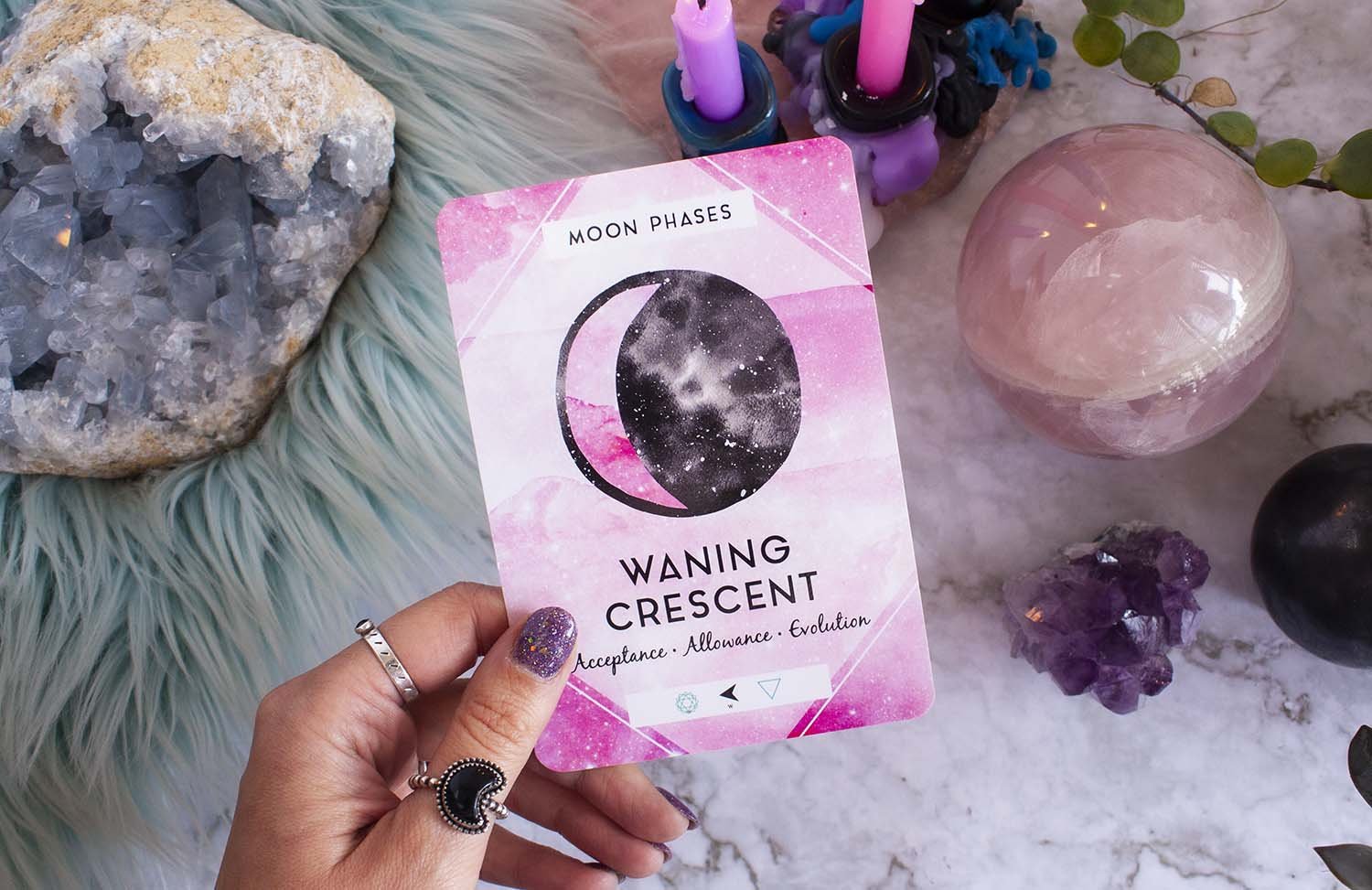
The waning moon phase is nature's way of calling you inward. How can you truly know what you need to release, shed, or let go of if you haven't allowed yourself time to go inward and fully experience your emotions? This phase is your invitation to feel and allow.
The waning moon phases occur after the peak of the full moon to the dark moon. Energetically this phase represents a time of allowance, acceptance, and shedding.
Growing up, most of us are taught to bottle our feelings up rather than sinking into them and accepting what is. Acceptance doesn't mean rolling over and taking it or being okay with the status quo. Not by a long shot. Acceptance of the current moment means allowing yourself to fully experience whatever is bubbling up in you at the present moment.
If things in your life, or the world at large, are not aligned with your desires and want them to change, you don't have to accept them as they are. What you do need to accept is your feelings about these situations. It's in the allowance and acceptance of situations that healing, growth, and change can occur.
There's an opportunity to grow from every situation you're presented with, and this phase asks you to be open to the learning and evolving process rather than pushing against it. Imagine the energy of this lunar cycle as a big unconditional and loving hug.
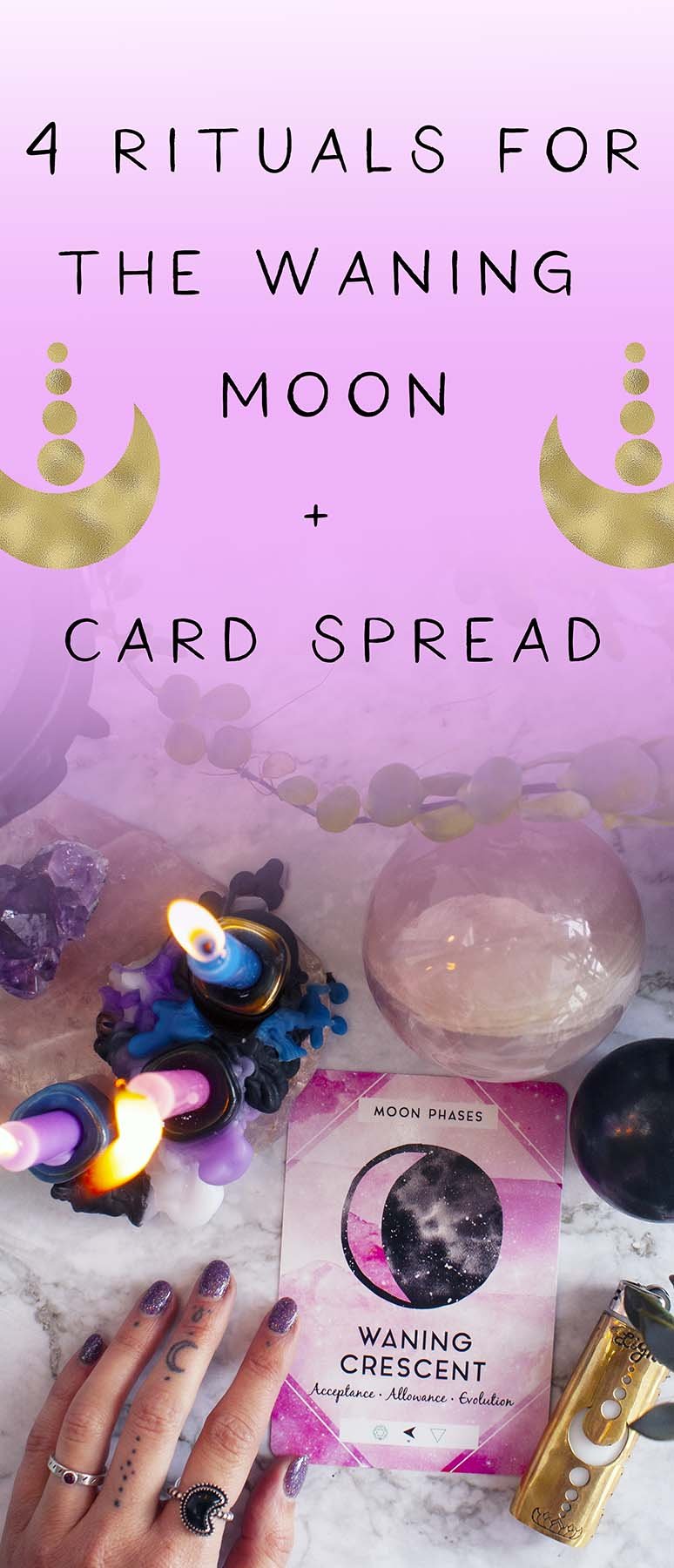
Here are a few keywords to understand the basic energy of this lunar phase.
Energetic Themes for the Waning Moon
Passiveness
Acceptance
Allowance
Releasing
Shedding
Resting
The rituals outlined below will work well together, but if you don't have the time or tools to perform all of them at once, that's okay, do what feels most aligned with your needs. Keep reading for four ritual suggestions for the waning moon phase.
1. Candle Ritual for the Waning Moon
Candles are an ideal ritual tool for this moon phase because they can be used as a very passive tool. I suggest using this candle ritual suggestion in tandem with one of the ritual suggestions below so your candle can burn as you sink into a ritual. There's more than one candle color that will work for this lunar phase, here are three suggestions, go with what feels best for where you're at, or use all three!
Pink candle: Pink candles offer soft and loving energy. This candle color is ideal for bringing in self-love and acceptance. This candle color is often suggested during the waxing moon phase to call in romantic love. For the waning moon phase, its energy will be used as a tool to call in self-love.
Blue Candle: Blue candles offer peace and respite. If you've been in a cycle of overwhelm and feel like you can't catch a break, this is your candle. The energy of this candle can help you soften into the present moment to access your emotions better.
Purple Candle: Purple candles offer inner wisdom and perspective. If you're in a place of allowance with your emotions but struggling with accepting them, the energy of a purple candle can help open you up to a higher perspective and shed light on why you feel the way you do.
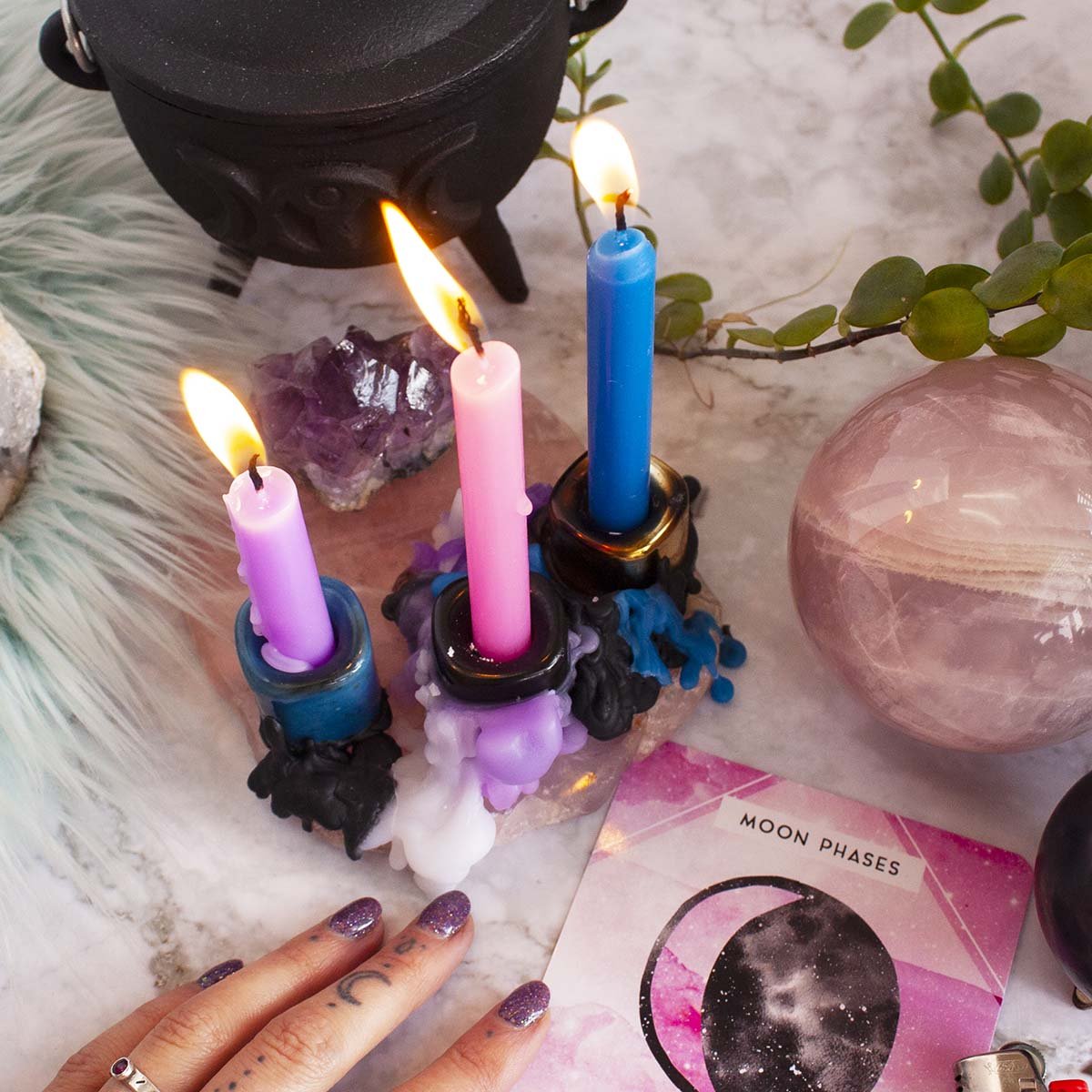
If candle magick is new to you, and you'd like to learn more about how it works and the process I outline here, check out this past blog post on candle magick basics.
Once you've selected your candle color(s), you may want to anoint your candle with a specific oil. I suggest lavender, bergamot, rose, or geranium work well with the energy of the waning moon. If you don't have any of these available, a simple carrier oil, like almond or coconut oil, will work just fine.
Anoint your candle with your oil, hold it in your hands, and impress it with your energy. Repeat this intention or something like it that feels good to you, "I love and accept myself as I am. I am allowed to feel the fullness of my emotions and will let them flow through me. I trust that Spirit will show me what needs to stay and what needs to go. So it is."Light your candle(s) and stay with it as it burns.
2. Waning Moon Meditation
If you're going to do any of these waning moon rituals, meditation is my top suggestion. I covered this topic in-depth in a previous post, so I'm not going to spend too much time discussing it here. But, if you've followed me for long, you know that I adore meditation.
Meditation opens you up to your inner world, which is step one in allowance and acceptance. As I said above, you have to take the time to explore your inner landscape before you can truly know what needs to be released. Meditation and internal reflection is the first step in this process.
Click here to get my free waning moon meditation or here to read my previous blog post on meditating with each moon phase.
If you'd like to add some supportive crystals to your waning moon meditation, I suggest rose quartz and a grounding stone of choice like obsidian, black tourmaline, or garnet.
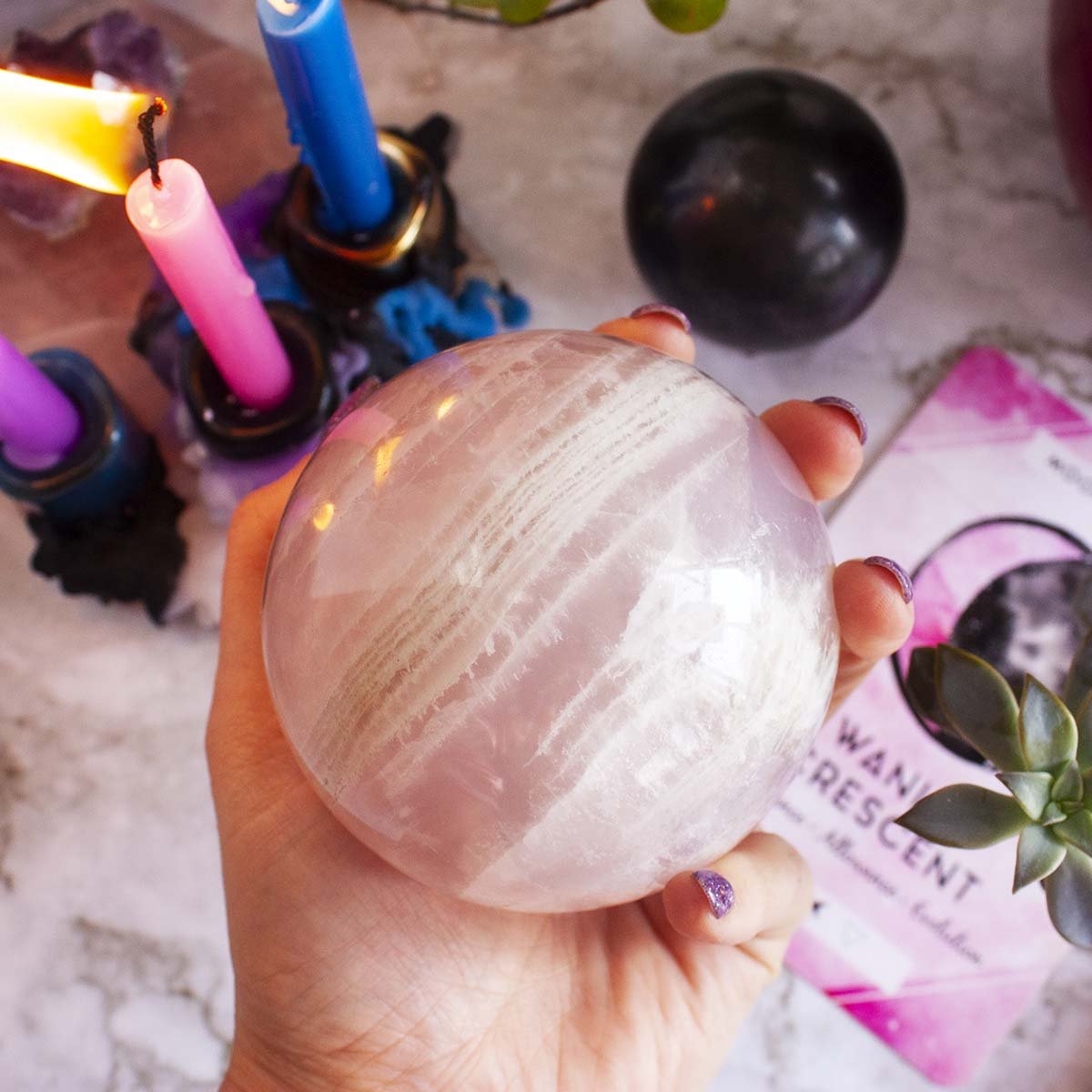
3. Waning Moon Card Spread
Use this card spread with your favorite oracle or tarot card deck. These questions can offer guidance on finding more acceptance in your life and suggestions for releasing anything holding you back from your highest good.
If you didn't begin with the candle ritual or meditation suggestion above, take a moment to connect with your breath and ground yourself.
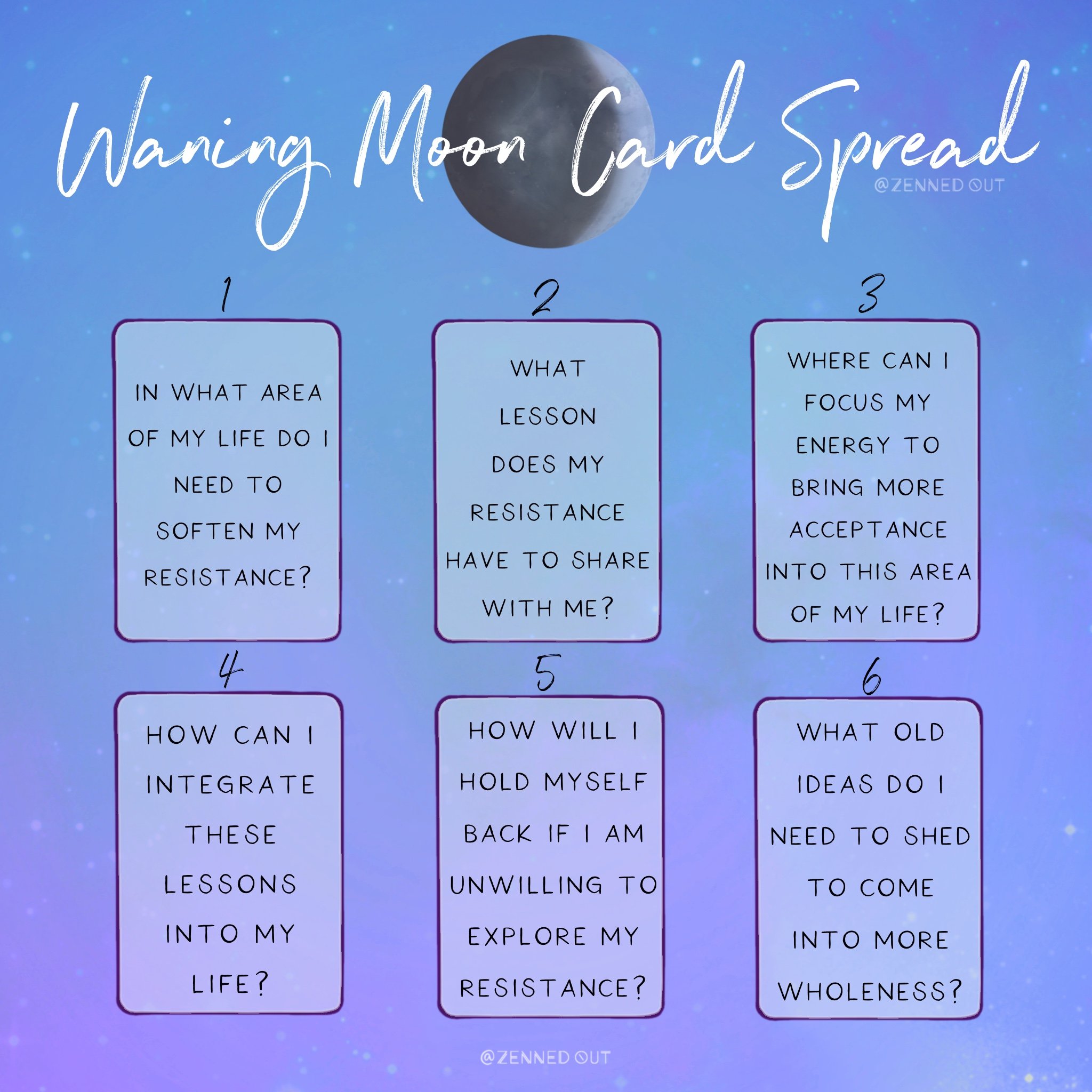
In what area of my life do I need to soften my resistance?
What lesson does my resistance have to share with me?
Where can I focus my energy to bring more acceptance into this area of my life?
How can I integrate these lessons into my life?
How will I hold myself back if I am unwilling to explore my resistance?
What old ideas do I need to shed to come into more wholeness?
Be open and honest as your cards reveal guidance to you. The next ritual can help you uncover any confusion you may have about your reading. If your reading is initially unclear, leave it, be open to signs from Spirit, and revisit it at a later time.
4. Write and Release
This ritual suggestion works well after performing either the waning moon meditation or waning moon card spread because you should be fresh with emotion and insight. Take some time to write about what came up for you. Alternatively, if tarot and oracle cards aren't your thing, you can use the card reading questions above as journal prompts.
Writing is a powerful tool for exploring, feeling, processing, and releasing your emotions. Here's a conclusion from a study conducted on the healing benefits of writing: "There is power in written expression and the personal sharing of one's story. Writing shows promise not only as a therapeutic tool during intervention, but as an ongoing avocational activity with many personal and health benefits."
Try to write without judging what you're writing and let your thoughts and feelings flow.
Choose to release your writing in a way that feels good to you. You can burn the paper in a fire-proof vessel, bury your text in the earth, release it into a flower body of water (ensure that your paper is compostable if you do this method!), or something else that feels good to you. You cannot do wrong; the purpose of all ritual is to bring meaning and healing to your experience, so trust that the releasing method you select is what will serve you best.
I hope you feel empowered to love and accept yourself fully, emotions, and all. Dance with all aspects of your being. Know that in each moment, even the uncomfortable ones, there is an opportunity to go deeper and find wholeness.
A Card Spread for Eclipse Season
Eclipses can seem scary, and they are certainly a powerful energy! Generally, eclipses are thought to be wild cards, magnifying the energy of a new moon (for a solar eclipse) or a full moon (for a lunar eclipse). I like to think of eclipses as portals for endings and beginnings —things may be “eclipsed out” or “eclipsed in.” It’s common for births, moves, engagements, new jobs, break-ups, new relationships, and more to happen around eclipses and during eclipse season.Eclipses can also be powerful illuminators, bringing hidden truths and feelings to the light for us to work with and heal through.
Three Dark Moon Rituals
The dark moon is one of my personal favorite times of the cycle. It’s the last few days of the waning time of the cycle, when the moon continues to shrink and eventually disappears from the sky.Different traditions honor the dark moon at different times. Personally, I honor the dark moon when you can’t see the moon at all in the sky--which is technically the new moon. Others honor the dark moon the last few days before the new moon. I recommend using your intuition and noticing how you feel during these days to understand when to honor the dark moon versus new moon.

The dark moon is one of my personal favorite times of the cycle. It’s the last few days of the waning time of the cycle, when the moon continues to shrink and eventually disappears from the sky.
Different traditions honor the dark moon at different times. Personally, I honor the dark moon when you can’t see the moon at all in the sky--which is technically the new moon. Others honor the dark moon the last few days before the new moon. I recommend using your intuition and noticing how you feel during these days to understand when to honor the dark moon versus new moon.
So what is the dark moon all about?
The dark moon is our time for radical rest, for deep clearing and releasing, and turning within. This is the time to cancel plans, to do shadow work, to go to sleep early and wake up late, and to pull tarot or oracle cards to tune in to your inner voice.
Keep scrolling for a few rituals to consider working with at this time.

WATER SPELL FOR CLEARING
One of my favorite spells to work during the dark moon is this simple water spell. Water is a helpful element for cleansing and purification, and this spell works especially well when the dark moon is in a water sign--Pisces, Cancer, or Scorpio. You’ll need:
A large glass of water
A piece of paper and pen
To start, choose what you’re focusing on releasing. Maybe there are blocks to self-expression, fear of being rejected, shame around your path, or blocks to abundance. Once you’ve decided what you’re ready to release (you’re welcome to spend some time journaling on this to get clear), start making a list of all the limiting beliefs and stories that you hold associated with this block.For example, let’s say you’re working with clearing blocks to abundance. Your list might hold beliefs like:
I can’t make money doing what I love
People with money are jerks
It’s wrong to have money when other people have so little, etc.
Keep letting the beliefs flow! I tend to fill up a whole page when I do this spell.
Once you have your list, it’s time to work the spell. Ground yourself, cast your circle, and pick up your list. You’re going to say the first belief out loud, starting with “I clear the belief that ________ from my body” and then taking a big sip of water. Pause and notice, feeling and visualizing the water moving through your body, cleansing this belief from your system on every level.
Repeat this for each belief on your list, taking your time and really feeling the beliefs move out of your body.

Card featured from The Ritual Deck
When you’re done, use the energy of your palms to charge your last sip of water with what you do want - abundance, healthy self-expression, creativity, etc. - and feel your whole body being charged with this intention by the power of the element of water.
Give thanks to water and the Universe for their help, ground yourself again and open your circle.
CANDLE MAGICK FOR RELEASING
For this spell, you’ll need:
Black taper candle
Carving tool like a sharp point crystal, toothpick, or athame
Black tourmaline, smoky quartz, or petrified wood
A simple oil like grapeseed or bergamot essential oil
Rosemary
Start by cleansing all of your items for the spell. This can be done by wafting rosemary smoke over them or visualizing light cleansing them.
For this spell, you’ll be carving what you’re releasing into your candle as well as the glyph for Pluto, the planet that helps things die and be transformed. For your words, keep them simple and powerful by carving the basics of what you’re releasing like “fear” or “self-doubt.”
Anoint your candle with your oil and roll it in your dried rosemary. As you carve and anoint your candle, visualize your all of whatever you’re releasing - your fear or your self-doubt as in the example above - pouring into the candle.
Place your crystal(s) and candle on your altar, light your candle, and start meditating on the flame. Continue to visualize all that you’re releasing pouring into the candle, and watch as it burns and turns to smoke. Stay with this meditation until you feel a shift in your energy - until you really feel a release.
Let the candle burn out if you can or snuff out the candle and continue the same spell each night until the candle has burned completely.
SHADOW WORK TAROT OR ORACLE SPREAD
The dark moon is a deep invitation into shadow work.
What is shadow work?
Simply put, it’s an intentional exploration of our shadow side - the parts of ourselves that we reject, that we’re ashamed of, that we stuff down and hide. Click here to learn more about shadow work if you’re new to it!
For this ritual, you’ll want to create a ritual space - whatever that means to you. For me, it usually means cleansing my space with smoke beforehand, lighting incense, and lighting candles. Maybe you also like to take an essential oil bath beforehand, or sprinkle herbs in a circle around you.
All you’ll need for this ritual is:
A journal and pen
Spend a few moments grounding yourself, then shuffle your cards and pull a card for each of these questions:
What part of my shadow is rising to the surface to be worked with?
How has rejecting this part of myself manifested in my life?
How can I show this part of myself more love and integrate it into my whole self?

Give yourself the gift of sitting with your cards after you pull them. Spend time meditating on your cards, journaling about them, or even painting with them to process and understand what their messages are for you.
